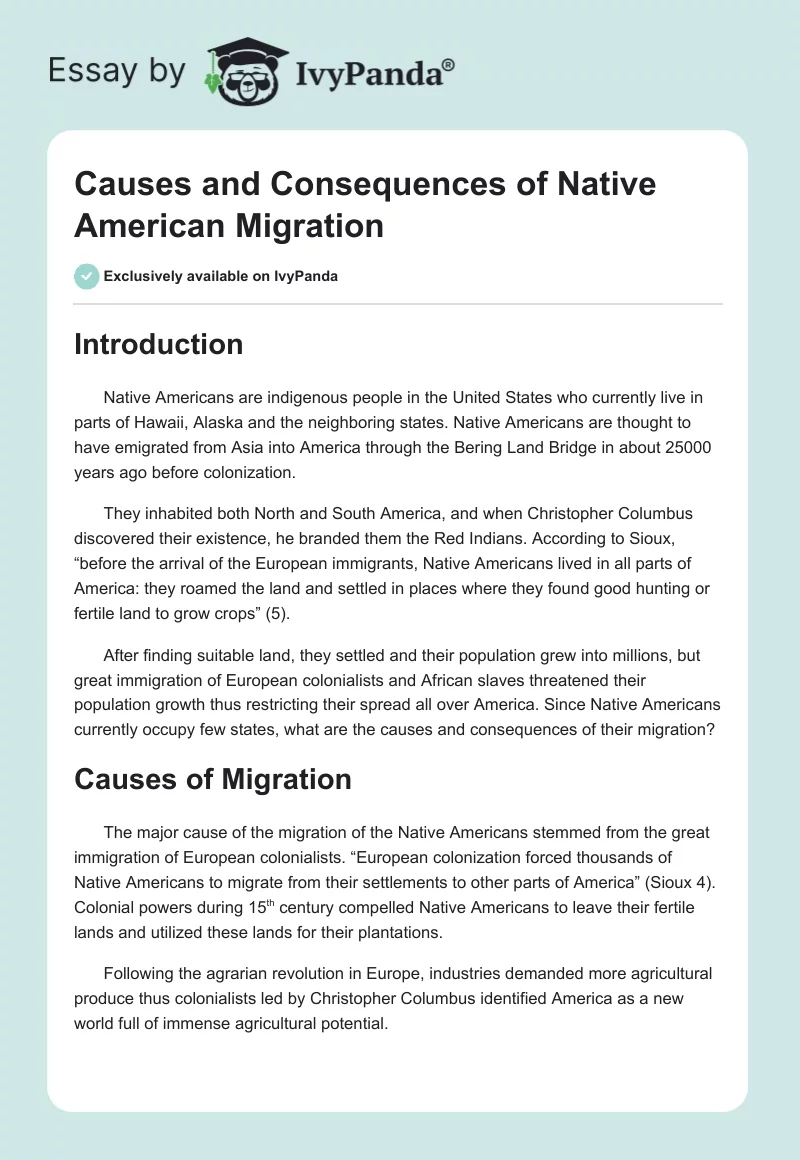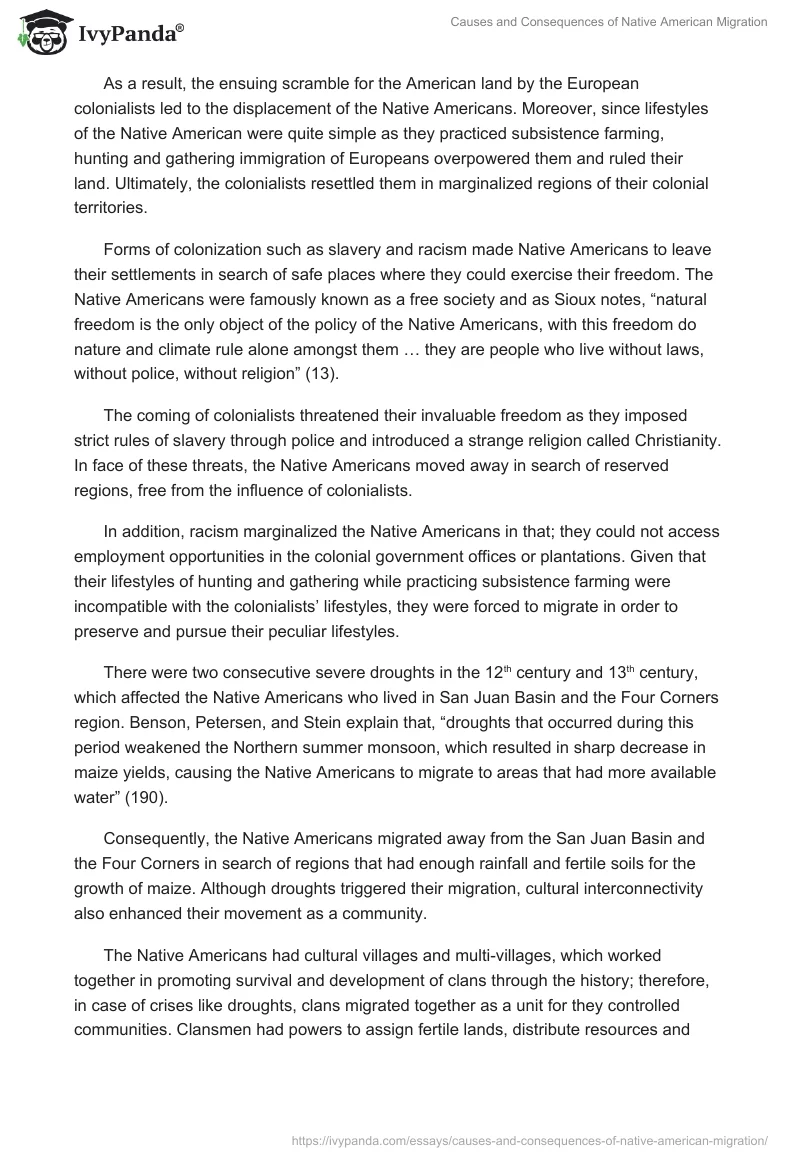Introduction
Native Americans are indigenous people in the United States who currently live in parts of Hawaii, Alaska and the neighboring states. Native Americans are thought to have emigrated from Asia into America through the Bering Land Bridge in about 25000 years ago before colonization.
They inhabited both North and South America, and when Christopher Columbus discovered their existence, he branded them the Red Indians. According to Sioux, “before the arrival of the European immigrants, Native Americans lived in all parts of America: they roamed the land and settled in places where they found good hunting or fertile land to grow crops” (5).
After finding suitable land, they settled and their population grew into millions, but great immigration of European colonialists and African slaves threatened their population growth thus restricting their spread all over America. Since Native Americans currently occupy few states, what are the causes and consequences of their migration?
Causes of Migration
The major cause of the migration of the Native Americans stemmed from the great immigration of European colonialists. “European colonization forced thousands of Native Americans to migrate from their settlements to other parts of America” (Sioux 4). Colonial powers during 15th century compelled Native Americans to leave their fertile lands and utilized these lands for their plantations.
Following the agrarian revolution in Europe, industries demanded more agricultural produce thus colonialists led by Christopher Columbus identified America as a new world full of immense agricultural potential.
As a result, the ensuing scramble for the American land by the European colonialists led to the displacement of the Native Americans. Moreover, since lifestyles of the Native American were quite simple as they practiced subsistence farming, hunting and gathering immigration of Europeans overpowered them and ruled their land. Ultimately, the colonialists resettled them in marginalized regions of their colonial territories.
Forms of colonization such as slavery and racism made Native Americans to leave their settlements in search of safe places where they could exercise their freedom. The Native Americans were famously known as a free society and as Sioux notes, “natural freedom is the only object of the policy of the Native Americans, with this freedom do nature and climate rule alone amongst them … they are people who live without laws, without police, without religion” (13).
The coming of colonialists threatened their invaluable freedom as they imposed strict rules of slavery through police and introduced a strange religion called Christianity. In face of these threats, the Native Americans moved away in search of reserved regions, free from the influence of colonialists.
In addition, racism marginalized the Native Americans in that; they could not access employment opportunities in the colonial government offices or plantations. Given that their lifestyles of hunting and gathering while practicing subsistence farming were incompatible with the colonialists’ lifestyles, they were forced to migrate in order to preserve and pursue their peculiar lifestyles.
There were two consecutive severe droughts in the 12th century and 13th century, which affected the Native Americans who lived in San Juan Basin and the Four Corners region. Benson, Petersen, and Stein explain that, “droughts that occurred during this period weakened the Northern summer monsoon, which resulted in sharp decrease in maize yields, causing the Native Americans to migrate to areas that had more available water” (190).
Consequently, the Native Americans migrated away from the San Juan Basin and the Four Corners in search of regions that had enough rainfall and fertile soils for the growth of maize. Although droughts triggered their migration, cultural interconnectivity also enhanced their movement as a community.
The Native Americans had cultural villages and multi-villages, which worked together in promoting survival and development of clans through the history; therefore, in case of crises like droughts, clans migrated together as a unit for they controlled communities. Clansmen had powers to assign fertile lands, distribute resources and make decisions that ensured survival of their respective clans and therefore, migration was the only way of surviving the effects of droughts.
Diseases also caused migration of the Native Americans. Great immigration of colonialists from Europe and slaves from Africa brought with them epidemic diseases such as measles, syphilis and small pox among others. “Epidemics were overwhelming cause of population decline and subsequent migration of the Native Americans since they lacked immunity to new diseases brought from Europe” (Benson, Petersen, and Stein 203).
For instance, small pox severely affected the Native Americans because it killed about a third of the pollution who lived in the western part of the colonial America.
Consequently, the Native Americans retreated to their native reserves, avoiding interaction with foreigners. Due to these epidemic diseases, their population drastically reduced forcing them to migrate in a bid to survive. Statistics show that, about 80% of the Native American population died during 16th and 17th century because of epidemic diseases, hence the rest 20% of the population survived through migration.
Another cause of migration of the Native Americans was wars. During colonial period and slavery, they fought both British and French militia, which overpowered and drove them away from their land. In addition, they fought during the Civil War hoping the American government would recognize their efforts, reward them by eliminating the longstanding discrimination, and shift them from their reserves into urban areas.
Unfortunately, “while the war raged and Africans Americans proclaimed free, the United States government continued its policies of assimilation, submission, removal, or extermination of Native Americans” (Baird 45). Therefore, the Native Americans suffered during wars making them to migrate to other areas as the government continued to relocate and marginalize them into their ancestral land.
Consequences of Migration
The constant migration of the Native Americans resulted into serious consequences that affected their economic, social, cultural, religious, and political lifestyles. Economically, the Native Americans lost their land through marginalization by the United States government.
Moreover, loss of property and human resources due to wars and diseases decimated their population with time. “In the 19th century the westward expansion of the United States incrementally expelled large numbers of Native Americans the east areas of their territory, either forcing them into marginal lands further west or by outright massacres” (Baird 48).
In addition, migration due to hostility of the immigrants and droughts did not give them enough time to settle economically, a factor that plunged them into abject poverty and vulnerability in terms of economic and political discrimination by the colonialists and the United States government.
Their economic status became even worse due to their fragile lifestyles of subsistence farming, hunting and gathering, since they lost vast tracts of land and squeezed themselves in small ancestral lands. As a result, the Native Americans’ population continued to dwindle and they lacked the numbers to push for any substantial reforms to accommodate them in the independent America.
As aforementioned, the continued migration of the Native Americans predisposed them to marginalization and discrimination. The arrival of the immigrants into their territories, outbreak of diseases, wars and colonialism continually pushed them out of their lands into reserves.
As the economy of the United States flourished, they were too far from economic mainstream, thus becoming more susceptible to the marginalization and discrimination that characterized the independent American government. Research studies conducted to find out the effects of immigrants on the labor market show that, “immigration reduces the labor market opportunities available to the less-skilled natives” (Camarota 35).
Influx of immigrants into the United States gradually led to reduction of the labor markets increasing unemployment to the already marginalized Native Americans. Since migration had negatively influenced their connection to mainstream economic activities, they had no access to employment and educational opportunities that would have eventually improved their lives economically.
The migration of the Native Americans resulted into intermarriages between clans or tribes. Sioux argues that, “intertribal mixing was common among Native American tribes … entire tribes occasionally split or merged to form more viable groups in reaction to the pressures of climate, disease and warfare” (23). Migration promoted mixing of genes since the Native Americans wanted to increase their decimated population by wars, diseases, massacres, droughts and migration effects.
The Native Americans intermarried with the Whites and African Americans; hence, the intermarriages increased their genetic diversity. The diversity of their genetic makeup enhanced their immunity against diseases like small pox because not all Native Americans were susceptible to small pox and other epidemic diseases as before their migrations and intermarriages.
The Native Americans lost their culture, religious beliefs, and language in the course of their migration and interaction with other communities.
Despite having unique culture that valued freedom, simple lifestyles of hunting and gathering coupled with forced migration did not give them ample time to preserve, practice and impart their cultural values, and as a result, the United States government failed to recognize them.
The government perceived them as uncivilized and embarked on strategies of ensuring that their children got the right education, which would civilize them.
Christian reformers introduced educational system that “proved traumatic to Indian children who were forbidden to speak their native languages, practice their religion and in numerous other ways forced to abandon their Indian identity and adopt European-American culture” (Fagan 42). In addition, interaction with the Whites and Africans made them change their hunting and gathering lifestyles. All these experiences led to transformations and loss of native culture, religious beliefs and language.
Conclusion
The Native Americans are the indigenous people of the United States but through the course of history; they have experienced marginalization and discrimination as though they were immigrants. Currently, the dominating populations in the United States are the European Americans and the African Americans, while the Native Americans are diminishing with time.
The Native Americans experienced varied hardships that made them migrate continually through centuries making their economical wellbeing very unstable. Although the United States gained the super power status, it continued to evict them into their ancestral lands and discriminated against their culture and religion.
They lost vast tracts of lands as result of migration and squeezed themselves in the marginal lands that were not fertile to support their healthy existence. Diseases and wars also decimated their populations reducing then into one of the minority groups in the United States America.
Works Cited
Baird, David. “We are all Americans in the Civil War.” Native Americans Journal 2.3 (2009): 44-50. Print.
Benson, Larry, Kenneth Petersen, & John Stein. “Pre-Columbian Native American Migrations.” Springer Journal 83.2 (2006): 187-213. Print.
Camarota, Steven. “The Wages of Immigration.” Centre for Immigration Studies 12.3 (1998): 3-39.
Fagan, Brian. Ancient North America: The Archaeology of a Continent. New York: Thames & Hudson Publishers, 2005.
Sioux, Tracee. Native American Migration. New York: Rosen Publishing Group, 2004


